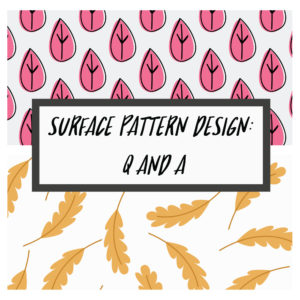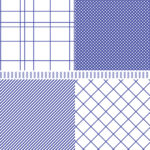
 When I thought about getting into surface pattern design I had a ton of questions. Do I need to be good at drawing? Can I learn from the internet or would I benefit from formal schooling? All of these questions were circling in my head and through a lot of research, I was able to find answers to them. To save you some time I thought I would compile 8 questions that I wanted to know the answers to when I started making patterns. The answers to these questions are based on my own experience and not the experience of surface pattern designers as a whole so keep that in mind when you read on.
When I thought about getting into surface pattern design I had a ton of questions. Do I need to be good at drawing? Can I learn from the internet or would I benefit from formal schooling? All of these questions were circling in my head and through a lot of research, I was able to find answers to them. To save you some time I thought I would compile 8 questions that I wanted to know the answers to when I started making patterns. The answers to these questions are based on my own experience and not the experience of surface pattern designers as a whole so keep that in mind when you read on.
What tools do I need to become a surface pattern designer?
I wrote about this more in depth in a different blog post but you really only need Adobe Illustrator. There are a few other things that make creating patterns easier which you can read more about here but to start out, invest in Adobe Illustrator. Things like tablets and other software like Photoshop can come later when you start making money off of your patterns.
Can I become a surface pattern designer without formal schooling?
There are benefits to formal schooling like access to a large alumni community where you can network. Formal schooling also helps people who are not self-motivated have a sense of structure, however, it’s costly and unnecessary. You can get an equally beneficial education from resources on the web including Skillshare.com, Make it in Design, YouTube, etc. for around $1000 as opposed to spending upwards of $20,000 dollars to go to a design college. Also, depending on how motivated you are, you will likely learn faster from learning online than going to school.
Do I need to be able to draw to be a surface pattern designer?
The beauty of Adobe Illustrator is you work in layers. Instead of trying to create the whole picture all at once as you do with drawing, with Illustrator you are piecing different objects and shapes together to create a bigger picture. Also with drawing lines on paper, once you place a line on the paper the only way to edit the line is to erase the line and start over. With Illustrator you can draw a line on your computer and slowly move the line until it is in the exact position you want it. These factors make drawing in Illustrator a completely different experience than drawing on paper and even the novice drawers can draw quite well in Illustrator.
What are some great courses you can take to learn surface pattern design?
While I haven’t taken any Make it in Design courses as of yet, those are the standard courses that people take to learn surface pattern design online. They also have many of the benefits that design colleges might have like partnerships with companies and networking opportunities. Gor those of you wanting that traditional design college experience without the cost this is a great alternative. For an even cheaper experience, I cannot say enough about Elizabeth Olwen’s and Bonnie Christine’s classes on Skillshare. Bonnie Christine does a good job of highlighting basic functions in Illustrator, so if you have no experience in Illustrator I would start out with Bonnie Christine’s class.
What schools offer surface pattern design degrees?
Even though money and time wise I would advise against getting a formal degree in surface pattern design, some of you may still want to go to college for the experience. Surface Pattern Design Guild has compiled a list of schools that offer surface pattern design degrees in the US, Europe, Asia, and Australia.
How do I make money as a surface pattern designer?
The typical ways that surface pattern designers make their money is through licensing their patterns to fabric companies like Joanns and other smaller fabric companies. For more information on licensing your patterns and getting your patterns seen the Creative Bloq has a great article about that here.
Opening up an online shop is another way surface pattern designers can make their money without the overhead of owning a brick and mortar shop. A few great websites where you can sell your patterns are Spoonflower, Society 6, and Creative Market.
Probably the most stable route to becoming a surface pattern designer is by working as an in-house designer. Any major clothing retailer likely has in-house designers, Nordstroms being one of them. Two of my favorite companies, Paper Source and Rifle Paper Co., also have in-house designers.
How to get your patterns noticed?
Shamelessly self-promote. When you think of people who shamelessly self-promote you typically think of those people in the comments of Youtube who say something along the lines of “It’s my dream to become a singer. Please check out my channel.” That is not what I am talking about here.
Pick a few social media sites and show your patterns on them. Create a website that links back to your social media sites. On that website, you should have a blog where you share about your patterns, provide tips and trick about surface pattern design, and maybe even provide freebies and reasons for people to come back to your website time and time again. The way Google works is the more links you have to your blog the more likely you will rank higher on Google so you don’t want a static blog that just showcases your patterns. Providing the occasional blog post will allow you to get those links you need to rank higher in Google as well as other search engines.
When you have gotten the hang of everything I mentioned above then you can venture into adding a shop on your website.
What is your biggest advice to surface pattern designers?
If you wait until your patterns are “ready” you will never progress. The problem with going into a creative field is being creative involves a lot of self-doubt. Don’t wait until your patterns are perfect because they will never be. Instead, get your patterns out there as soon as you believe you are ready to take your career to the next level. You tend to be more critical of your own patterns so getting your patterns noticed online will let you know if you are any good.
These are just a few of the questions you might have about surface pattern design. If you have any more questions leave a comment down below and I will try to answer them. If your question requires a more thorough response I ask that you email me at kelciemakespatterns@gmail.com so I can provide a more in-depth answer.
If you liked this post, why not share it! It lets me know what posts you like so I can make more posts like this.






Lucy
Great post. How many patterns or collections would you recommend having before approaching any clients or agents?
Kelcie Makes Patterns
This is a great question. I watched a video a while back in which a surface pattern designer by the name of Bonnie Christine suggested you have I think about 100 patterns. While I somewhat agree with that I will also say that I don’t think you should aim for a specific number. Getting to 100 patterns is good for practice, however, if your aim is to make 100 patterns you are going to start to get into the habit of making patterns for the sake of reaching a goal rather than making the best patterns you can make. If I had to put a number on it I would start by making about 15 pattern collections. Ideally you will probably make more than 15 and narrow it down to your fifteen best collections. If you don’t make it to 15 but feel like you are ready to show your patterns show 5 to 10 collections. The worst thing a company could do is say come back to me when you have more patterns. I hope this helps and if you have any more questions feel free to reply to this comment.
Lucy
Thank you so much, I have that many collections so I just need to work out what type of client I should be approaching. I have a lot of repeat patterns and some relevant to greetings
Kelcie Makes Patterns
You’re welcome. You will figure it out. I would just contact companies that you like and see if they take outside pattern submissions. If they do, send them your portfolio.